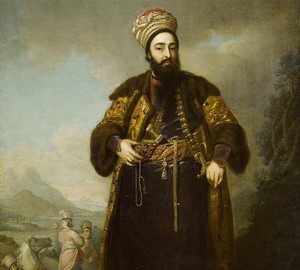“Portrait of Murtaza-Kuli Khan”, Borovikovsky – description

Description of the picture:
Portrait of Murtaza-Kuli Khan – Vladimir Lukich Borovikovsky. Canvas, oil. 58.7 x 41.5 cm
Brushes of Vladimir Lukich Borovikovsky belong to a huge number of portraits: ceremonial and chamber, female and male, military and municipal figures, kings and empresses.
The prototype of the ceremonial, monumental portrait of those times is the “Portrait of Murtaza-Kuli Khan.” A painting was made in one thousand seven hundred and ninety-6 years, commissioned by the Empress Catherine II herself.
Before us is the Iranian prince Murtaza-Kuli Khan, the brother of the ruler of Iran, Shah Aga-Mohammed Khan.
Catherine favored the troops of Murtaza, supported him in order to gain a foothold in the northern territories of Iran, which were very important for Russian trade. But Murtaza-Kuli Khan, having suffered several defeats, fled from his brother’s revenge to St. Petersburg, where he was graciously received by the empress.
Having paid attention to how Murtaza examined and was interested in the beauty of the Hermitage with a knowledge of the case, Catherine ordered Borovikovsky his portrait.
The position of the eastern khan is very great, principled and even festive. The left hand touches the saber, on the right hand are the rosary, showing his belonging to Islam.
The clothes are simply gorgeous. Thanks to Borovikovsky’s professional brush, we see how furs shimmer vibrantly on the shoulders and sleeves of a rich cape, how velvet dresses flicker with the deepest sapphire, how the fabric on the headdress reflects with golden highlights, how the jewels on the hilt and on the fingers generously shine.
The prince’s face is very curious: snow-white, thin, with a dark beard and sad, but orientally beautiful and mysterious eyes.
The general gamut of the color palette of the canvas can even be called generous and unique, pleasant to perceive. The background is a mountain landscape, smoothly turning into greenish vegetation.
In the same year, Borovikovsky painted another sketch and a cyclic portrait of Murtaza. In these works, the prince depicts mountains, people, and stallions.
The Iranian Khan Murtaza never managed to return to his homeland; he died in Astrakhan in one thousand eight hundred years."